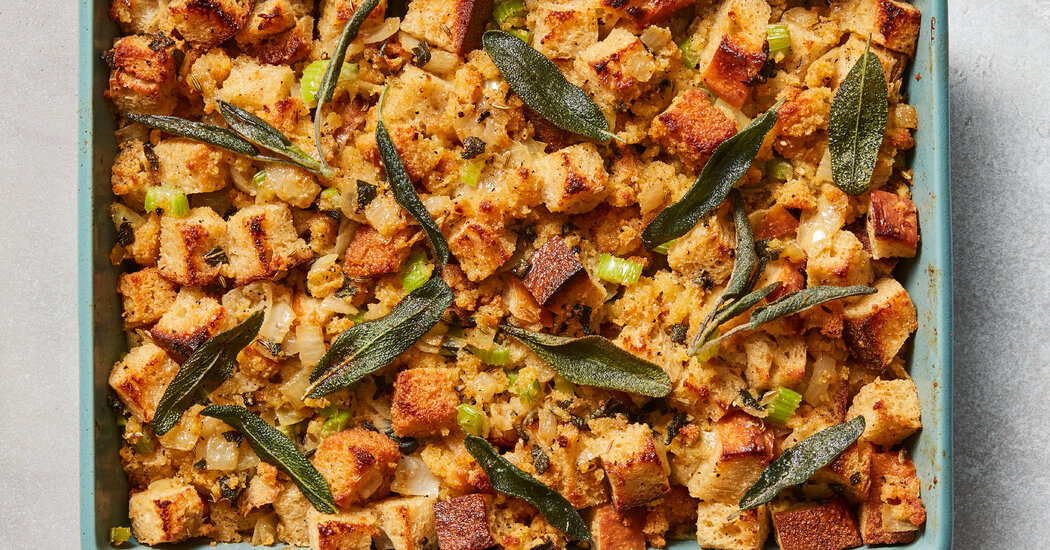
Last year, when I published a pizza-inspired stuffing recipe, some readers were vehement that sage-and-onion-infused traditions should not be messed with. “Is this a joke?” one commenter wrote. “You’d be laughed, if not chased, out of the South!” wrote another, adding that it’s called “dressing” there.
Who knew that soggy bread crumbs would be so intensely protected?
I’ve always considered stuffing to be a blank canvas, the greatest opportunity to express myself in an otherwise regimented Thanksgiving menu. But the feedback made me wonder: Are there rules to stuffing? Is there a platonic ideal?
In search of answers, I cooked and tasted 20 stuffing recipes — 18 beloved staples from the New York Times Cooking archives, as well as a couple of the most popular packaged mixes in the United States — with a simple goal in mind: to determine which components of the dish are most essential for buttery, carb-laden dynamism.
One big difference between the stuffing most commonly enjoyed in the United States today and the version that likely originated in ancient Rome is that stuffing no longer needs to … stuff. When we say stuffing now, what we often mean is dressing, which is really only a stone’s throw away from savory bread pudding.
Cooking through the 20 recipes, I found that I was traveling through time. After weeks of stuffing myself, I picked up the best pieces — crumb size, spices, hydration levels and textures — and cobbled them together into a new whole: my own essential American Thanksgiving stuffing.
Here’s how I got there.
Good stuffing is built on a good base. Midwestern wild rice stuffing is always a good time, and in New England, cracker crumbs are popular.
Many American families use regular sandwich bread, but an all-white-bread stuffing can taste one-note. While Southern cornbread stuffing is delicious, I found that it lacked structural integrity when moisture was introduced.
But a crusty loaf of tangy sourdough or a sturdy country loaf, paired with the sweetness of cornbread, made for a dynamic and familiar blend of flavors and textures.
The size of the bread crumbs matters. Ruth M. Siems, an inventor of Stove Top stuffing, helped come up with the ideal crumb size, structure and texture for optimal hydration. But what works for packaged stuffing, where water and butter provide the only moisture, doesn’t necessarily translate when you’re making it from scratch with fresh bread and vegetables.
Taking a page from Ms. Siems’s book, I wanted to devise my own optimal crumb size and found that half-inch cubes, fully dried out in the oven, made for the best texture and most flavorful result. These bread crumbs are big enough to hold up when hydrated but small enough to evenly distribute moisture, meaning no dry pockets.
Less is always more. What Marilyn Monroe’s 16-ingredient recipe from the 1950s lacked in cohesiveness — hard-boiled eggs, grated Parmesan, raisins! — was compensated for by an exciting (and delicious) give and take between textures and flavors.
But Mark Bittman’s seven-ingredient bread stuffing, which is based on a James Beard recipe, had more flavor than others that called for nearly twice as many elements. The ingredients didn’t have to compete for attention, and instead harmonized.
Though my recipe calls for two types of bread, the ingredient list stops at 10 items (not including salt and pepper). That’s because I kept my flavor goals focused.
Yewande Komolafe’s cornbread dressing, a unanimous favorite among my colleagues, reminded me how tasty buttery bread crumbs soaked in sausage fat can be.
What I liked about the sausage, however, wasn’t the added protein, but the flavor, which I was able to replicate (and amplify) by blooming sausage-adjacent spices like fennel seeds and ground cayenne in butter.
And to that point: Fat carries flavor. Kay Chun’s thoughtful French onion stuffing, which calls for an initial step of sautéing celery and fresh thyme in oil, inspired me to bloom my aromatics in the fat as opposed to just tossing everything in a bowl. You should always infuse your butter, oil or what have you, with the primary flavors you want the dish to take on.
Nothing tastes as vividly of the fourth Thursday of November as fresh sage. So in my recipe, whole leaves are fried in melted butter until crisp; as the sage browns, so does the butter, which is perfumed with the silvery-green herb’s woodsiness.
A little spice is nice. As I cooked through a glorious hashweh recipe from Reem Kassis, I yearned for an excuse to add warm spices like ground cinnamon, nutmeg and allspice to my stuffing. Ultimately, poultry seasoning — which includes rosemary, oregano, ginger, marjoram, thyme and pepper — provided a shortcut to warmth and played well with the gamy flavors of turkey.
Custardy texture relies on hydration. Since most stuffing recipes today don’t actually make it into a bird, the drippings that once came from the turkey need to be replaced with added liquid.
Unless you’re making a homemade turkey stock from scratch, skip store-bought stock, which tends to taste like water. Reach for something a little richer: You could add cream, like in this rich cornbread dressing, which Julia Moskin (who reported one of The Times’ most extensive dispatches on stuffing) adapted from Christina Liao, a home cook. But whole milk is a happy medium.
You could also add eggs, but if there’s enough fat and hydration, they’re not entirely necessary. In fact, their proteins can sometimes stiffen the overall texture, rather than make it fluffy.
I’m still darn proud of that pizza stuffing. But this year, I’ve distilled decades of lore into a recipe you might fit onto your table with glee.
I’ve always believed that if stuffing had a tagline, it would be: “What you’re really here for.” Rest assured that this stuffing, optimized for flavor and history, is worth the journey.
Watch Eric prepare all 20 stuffings on YouTube — and find 18 of the recipes on NYT Cooking.
Recipe: Thanksgiving Stuffing



